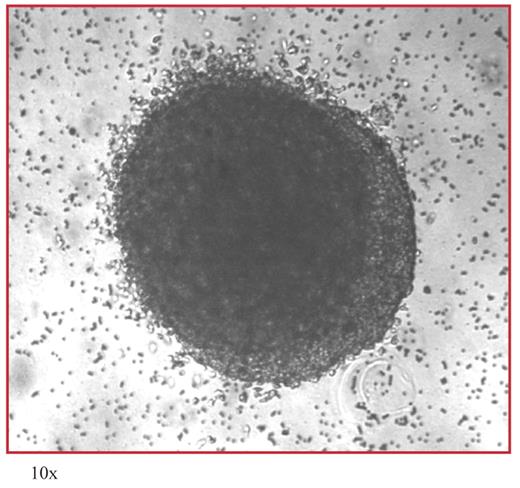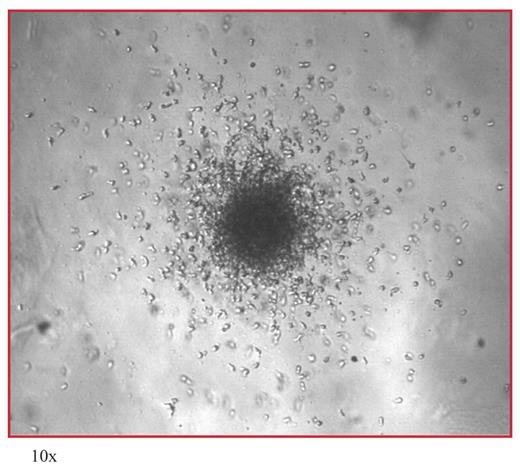Abstract
AML cell line 2006-5 was established by serial culture of an AML patients’ PBMC (M5).
Compared to primary AML cells, this line expresses CD13, CD33, CD15, CD4, CD86, CD54 but lost CD34, CD64, CD123 and HLA-Dr. A group of CD13−/CD33− cells was detected consisting of 0.2% of total cells, but no significant CD34, CD90 or CD123 expression cells could be detected by FACS. After depleting of CD13+/CD33+ cells by magnetic beads, the CD13−/CD33− cells were enriched to 95%. Significant CD34+, CD90+ or CD123+ cells (0.2–0.5%) appeared in the CD13−/CD33− enriched fraction of AML cells. Leukemia colony forming (LCF) cell assay analyzed at day 14 demonstrated CD34+, CD90+ or CD123+ cells selected by magnetic beads formed typical compact large colonies of more than 1000 cells representing 40–60% of total colonies (Fig left panel). The CD13−/CD33− enriched fraction formed medium colonies with a dense center surrounded by a halo of migrating cells (80–90% of total colonies) (Fig right). Untreated 2006-5 cells formed small diffuse colonies (70–80%). Re-plating of compact colonies selected from CD34+, CD90+ or CD123+ cell LCF assays formed the above 3 type of colonies in one culture dish. Although a daughter line can be generated from a single colony formed by CD13-CD33− cells, no compact colonies could be observed in re-plating experiment. After 14 days of culture, immature erythroid cell clusters were observed in the area surrounding compact colonies suggesting that the progenitors of the colony forming leukemia cells were at the GEMM stage. Small colonies of untreated cells gradually became apoptotic and necrotic after 10 days. These results support the theory that AML is organized as a hierarchy similar to the normal hematopoietic system. CD34+, CD90+ or CD123+ cells with very low frequency of 1–2 in 1×105 2006-5 line cells demonstrated high proliferation and differentiation potential, and may represent leukemia stem cells. CD13−/CD33− cells with lower proliferation rate may belong to more differentiated leukemia progenitors without self renew potential. If additional experiments support the notion that cells forming compact colonies are leukemia stem cells, they may serve as a useful resource to test the biology of leukemia and its therapy.
Disclosures: No relevant conflicts of interest to declare.



This feature is available to Subscribers Only
Sign In or Create an Account Close Modal